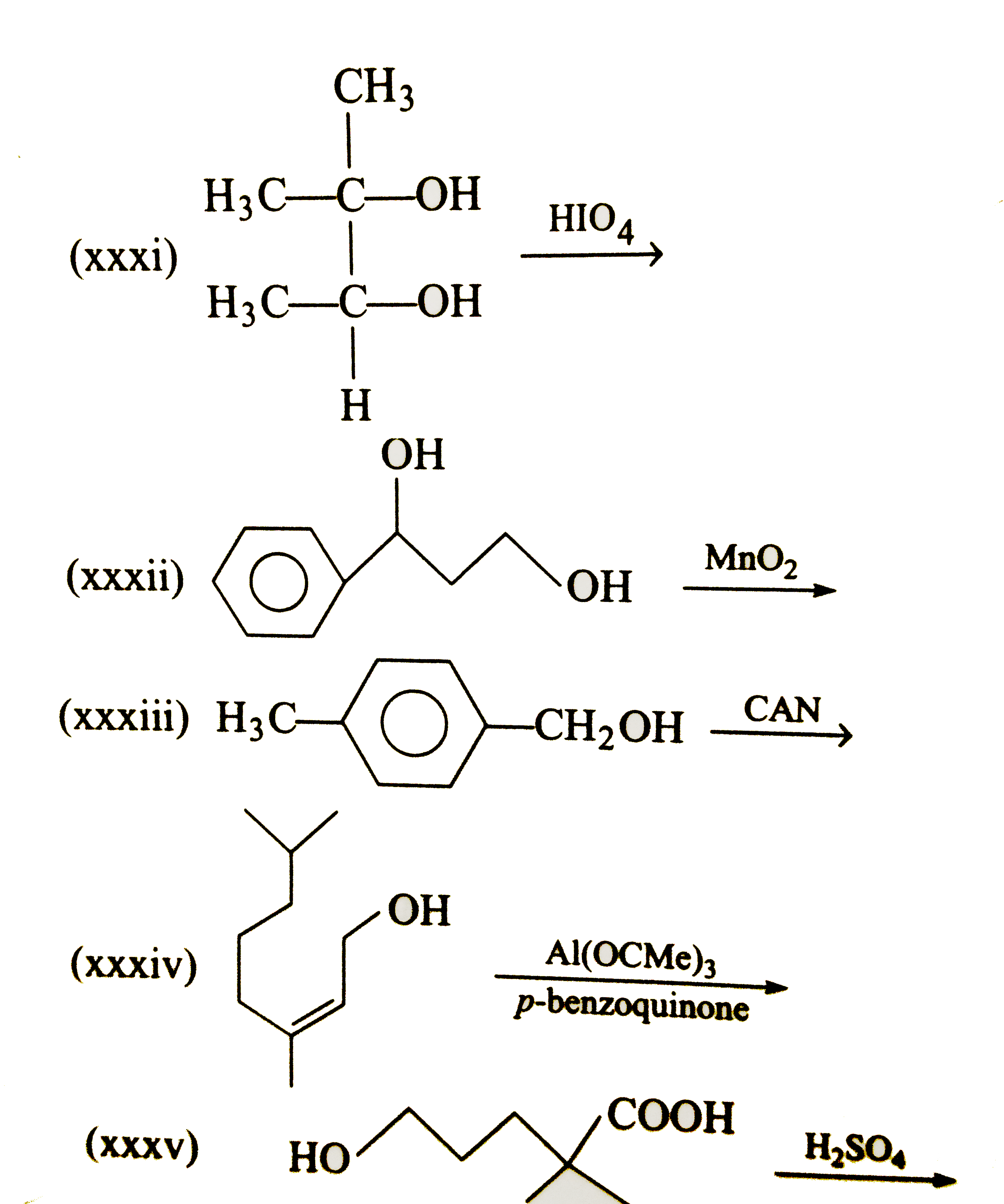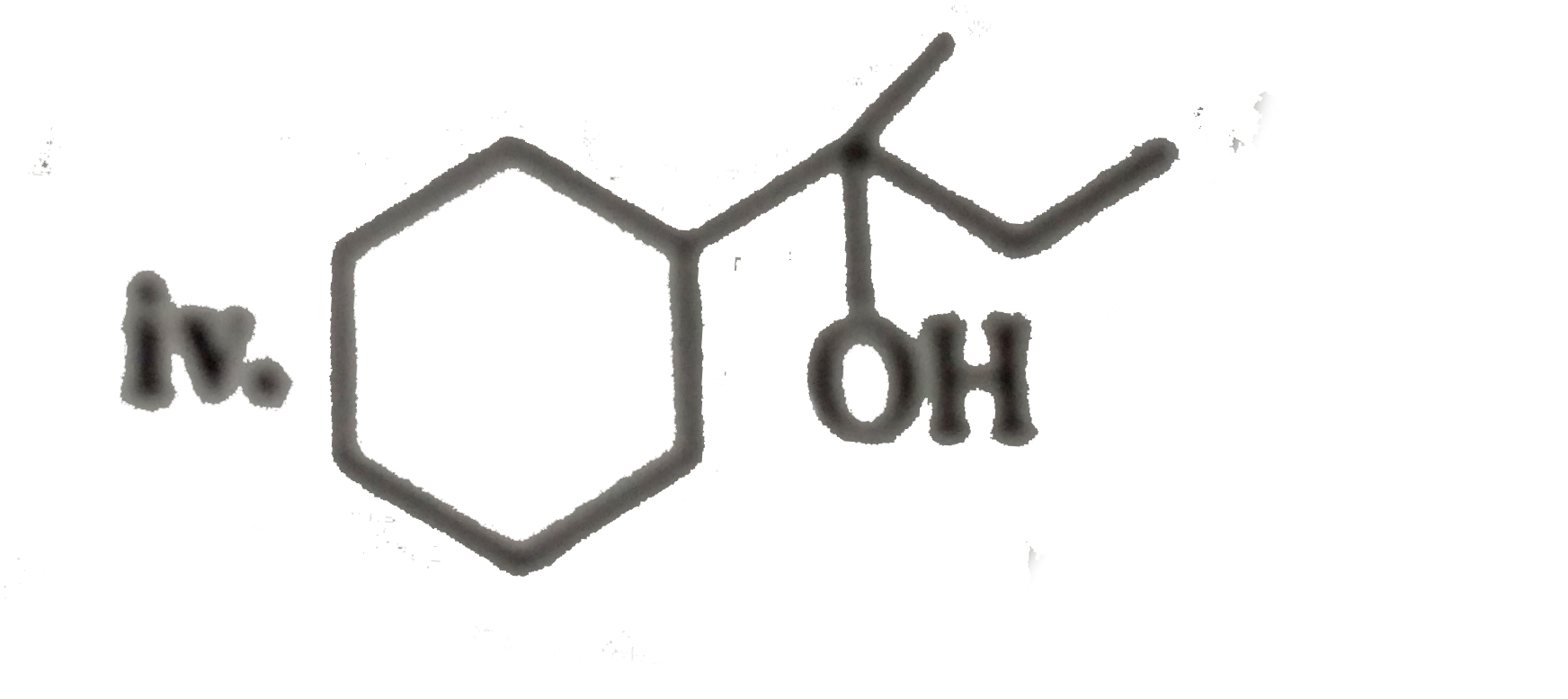Complete Solutions to PROBLEM FOR PRACTICE of chapter ALCOHOLS, PHENOLS AND ETHERS of Class 12 book with complete answers and questions
| Class 12 | CHEMISTRY |
| Chapter | ALCOHOLS, PHENOLS AND ETHERS |
| OP TANDON | PROBLEM FOR PRACTICE |
| Number Of Questions | 19 |
| Academic Year | 2023-24 |
Complete the following equations `:`


View SolutionWhat happens when ?
(a) Sodium metal reacts with absolute alcohol.
(b) Vapour of ethyl alcohol is passed through heated aluminium oxide at 633K.
(c ) Glycerol is heated with `KHSO_(4)`.
(d) Ethyl alcohol reacts with acetyl chloride.
(e) Ethyl alcohol is heated with iodine and NaOH.
(f) Ethyl alcohol is heated with bleaching powder.
(g) Ethylene glycol is heated with concentrated `H_(2)SO_(4)`.
(h) Isopropyl alcohol is oxidised with acidic potassium dichromate.
(i) Ethyl alcohol is treated with conc. `H_(2)SO_(4)` under different conditions.
(j) Tertiary buty alcohol is passed over heated copper at 573K.
View SolutionWrite IUPAC names of the following `:`
(a) teritary Butyl alcohol
(b) secondary Butyl alcohol
(c )
(d) `HC-= C-CH_(2)OH`
( e) `H_(2)C=CH-underset(OH)underset(|)(C)H-CH_(3)`
(f) Chloral hydrate
(g) Isoamyl alcohol
(h) Diethyl carbinol
(i) Ethyl methyl isopropyl carbinol
(j) `CH_(3)-underset(Cl)underset(|)(C)H-underset(Cl)underset(|)overset(Cl) overset(|)(C)-CH_(2)OH`
(k) `CH_(3)CH=CHCH_(2)OH`
(l) `H_(2)C=CHCH_(2)OH`

View SolutionGive the majore product formed when each of the following is heated in the presence of conc. `H_(2)SO_(4)` or `H_(3)PO_(4)`

View SolutionWhat is the major product formed when each of the following is treated with HCl ?

View SolutionSynthesise the following alcohols by using Grignard reagent.

View SolutionStarting from glycerol, how will you obtain the following ?
(a) Acrolein (b) Allyl alcohol
(c ) 2-Iodopropane (d) Nitroglycerine
(e ) 1,2,3-Trichloropropane (f) Glyceric acid
View SolutionOutline a synthesis of each alcohol from the indicated starting materials.
(a) Isopropyl alcohol from a hydrocarbon.
(b) n-Butyl alcohol from acetylene.
(c ) Ally alcohol from propene.
(d) Glycerol from acetone or isopropyl alcohol or propene.
(e ) Glycerol from carbon and hydrogen or acetylene.
(f) n-Propyl alcohol from ethylene oxide.
(g) tert-Butyl alcohol from acetone.
(h) Isopropyl alcohol from acetaldehyde.
(i) 2-methyl propan-1-ol from formaldehyde.
(j) Cyclohexyl methanol from formaldehyde.
(k) 1-Phenylethanol from styrene (vinyl benzene).
(l) tert-Amyl alcohol from methyl magnesium iodide.
(m) 3,5-Dimethylhexan-3-ol from butan-2-one.
(n) Butan-1-ol from but-1-ene.
(o) Butan-2-ol from but-1-ene.
(p) Allylalcohol from propane.
View SolutionHow will you obtain ?
(a) Propane-1-ol from propan-2-ol (three steps)
(b) Ethanol from methanol (three steps).
(c ) Vinyl acetate from ethyl alcohol.
(d) Ethanol from acetylene.
(e ) n-Propyl alcohol from ethyl alcohol (four steps).
(f ) tert-Butyl alcohol from isobutyl alcohol.
(g ) Methyl alcohol from acetic acid.
(h) Acetamide from ethyl alcohol.
(i) Formic acid from oxalic acid.
(j) Butan-1-ol from acetaldehyde.
View SolutionHow will you distinguish among the following pairs?
(a) n-Propyl alcohol and isopropyl alcohol
(b) n-Butyl, sec-butyl and tert-butyl alcohols.
(c ) Ethanol and chloroform.
(d) Ethanol and acetone.
(e ) Ethanol and propan-1-ol.
(f) Glycerol and suger solution.
(g) Allyl alcohol and n-propyl alcohol.
View Solution(a) Write the structural formula of the main organic product formed when ethyl acetate is treated with twice the molar quantity of ethyl magnesium bromide and the reaction mixture is poured into water.
(b) Give the structures of Grignard reagent and the substrate (aldehyde or ketone) that would react to form 2,4-dimethyl pentan-3-ol.
(c ) By giving one chemical reaction prove that glycerol is an alcohol.
(d) Give one specific example to prove that enzymes are very specific in their action .
(e ) Write down the names and structures of two compounds obtained by dehydration of ethyl alcohol.
(f) List the reagents commonly used to reduce carbonyl functional groups to alcohols.
(g) Give the expected reduced product from the reaction of
`(a) CH_(3)COCH_(2)COOH," "(b)OHC CH_(2)C OO CH_(3)`
`(c ) CH_(3)CH_(2)COCH_(2)CH_(2)Br," "(d)p-O_(2)N-C_(6)H_(4)CHO` with `(i) NaBH_(4),(ii)LiAlH_(4)`
(h) Give the product of the oxidation with `MnO_(2)` of `:`
`(a) CH_(3)CH_(2)CH=CHCH_(2)OH`
`(b) C_(6)H_(5)CH_(2)OH`
`(c )C_(6)H_(5)CH(OH)CH_(2)CH_(2)OH`
`(d) CH_(3)CH=CHCH_(2)CH_(2)CH_(2)OH`
(i) Give the product of the oxidation with Jones reagent of `:`
`(a)CH_(3)CH=CHCH(OH)CH_(3)" "(b)C_(6)H_(11)CH_(2)OH`
View Solution(i) Arrange the following in order of their increasing boling point.
`H_(2)O,OH^(-),CH_(3)OH,CH_(3)O^(-)`
(ii) Arrange the following in order of their increasing boiling point `:`
n-butane, ethanol, water, propane.
(iii) Arrange the following in order of their increasing boiling point `:`
n-butan, n-butanol,n-butyl chloride,isobutane.
(iv) Arrange the primary, secondary and tertiary alcohols into decreasing order of reactivity towards sodium.
(v) Arrange the primary, secondary and tertiary alcohols into decreasing order of acidity .
(vi) Arrange the following in order of their decreasing boiling point `:`
pentan-1-ol,2-methyl butan-2-ol,3-methyl butan-2-ol.
(vii) Arrange the following in decreasing order of rate of dehydration with conc. `H_(2)SO_(2) :`
`CH_(3)CH_(2)CH(OH)CH_(2)CH_(2)CH_(3)(A)`
`(CH_(3))_(2)C(OH)CH_(2)CH_(2)CH_(3)(B)`
`(CH_(3))_(2)C(OH)CH(CH_(3))_(2)( C)`
`CH_(3)CH_(2)CH(OH)CH(CH_(3))_(2)(D)`
`CH_(3)CH_(2)CH_(2)CH_(2)CH_(2)CH_(2)CH_(2)(E )`
View SolutionGive reasons for the following `:`
(i) Molecular mass of ethanol and dimethyl ether is the same, however ethanol is a liquid at room temperature but dimethyl ether is a gas.
(ii) Anhydrous `CaCl_(2)` cannot be used for drying ethanol
(iii) tertiary Alcohols form the turbidity fastest in Lucas test while primary alcohols form slowest.
(iv) Ethyl alcohol reacts with HI but not with HCN.
(v) Sodium metal can be used for drying diethyl ether but not ethanol.
(vi) Propanol, unlike propane is soluble in water.
(vii) Propanol boils at a higher temperature than propane.
(viii) Why glycerol has high viscosity and is miscible with water in all proportions ?
(ix) Reactivity of HX with alcohols is in the order, `HI gt HBr gt CHl gt HF`
(x) Why is it not posssible to obtain a halide by reacting ROH with `X^(-)` ?
(xi) `ClCH_(2)CH_(2)OH` is stronger acid than `CH_(3)CH_(2)OH`.
(xii) Hydration of 3-phenylbut-1-ene in dil. `H_(2)SO_(4)` forms 2-phenylbutan-2-ol instead of 3-phenylbutan-2-ol.
(xiii) The compound `(CH(3))_(2)C-CH(OH)CH_(3)` on treatment with conc. `HCl` forms `(CH_(3))_(2)C(Cl)-CH(CH_(3))_(2)` instead of `(CH_(3))_(3)C-CH(Cl)CH_(3)`
(xiv) Acid catalysed dehydration of t-butanol is faster than that of n-butanol.
(xv) When t-butanol and n-butanol are separately treated with a few drops of dilute `KMnO_(4)`, in one case only, the purple colour disappears and a brown precipitate is formed. Which of the two alcohols gives the above reaction and what is brown precipitate ?
View SolutionShow how would you synthesisse the following alcohols form approprite alkenes.
i. ii.
ii. 
iii. iv.
iv. 
View SolutionOutline a synthesis of each alcohol from the indicating starting materials `:`

View SolutionShow how would you synthesize the following alcohols from ethyl lithium ?
(i) Butan-1-ol, (ii) Butan-2-ol, (iii) 2-Methylbutan-2-ol, (iv) 3-Ethyl-2,4-dimethylpentan-3-ol.
View SolutionCarry out the synthesis of the following alcohols from ethyl magnesium bromide `:`
(i) Pentan-1-ol, (ii) 3-Methylpentan-2-ol
View SolutionStarting from ethanol and propan-1-ol,how pent-2-ene is prepared using Grignard reagent ?
View Solution(A) Give the mechanism of pinacol-pinacolone rearrangement reaction.
(B) Whatt is the final product when each of the following is treated with `H^(+)` or dil. `H_(3)PO_(4)`.

View Solution
PROBLEM FOR PRACTICE questions and complete solutions for chapter ALCOHOLS, PHENOLS AND ETHERS of G.R. BATHLA & SONS CHEMISTRY (HINGLISH) of Class 12
All Exercises from OP TANDON Class 12 CHEMISTRY ALCOHOLS, PHENOLS AND ETHERS
- (C )ETHERS
- ASSERTION-REASON
- BRAI STORMING PROBLEMS
- ETHERS
- ETHERS Passage 6
- Ethers SET1:
- ILLUSTRATION OF OBJECTIVE QUESTINS
- LINKED COMPREHENSION Passage 1
- Matching Type
- MATRIX -MATCH
- OBJECTIVE QUESTIONS (LEVEL-A)
- OBJECTIVE QUESTIONS (LEVEL-B)
- passage 2
- Passage 3
- Passage 4
- Passage 5
- Passage 7
- PHENOLS
- PROBLEM
- PROBLEM FOR PRACTICE
- PROBLEMS BASED ON STRUCTURE AND PROPERTIES
- SET II
- SETII
- SINGLE INETER ANSWER TYPE QUESTIONS / ALCOHOLS AND PHENOLS
- Some SOLVED PROBLEMS